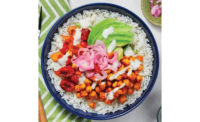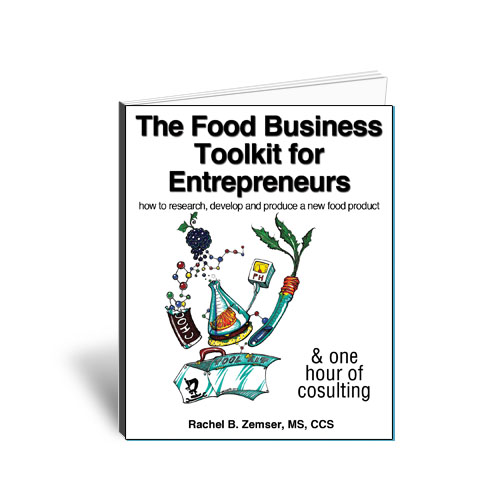Stay Ahead of the Food Curve








New food products are all around, all the time, popping up on the menus at favorite restaurants. Food processors have to keep innovating and developing new products, if they want to succeed in an increasingly competitive industry. Most—if not all—manufacturers understand the need for continual product innovation. But, in an industry as multifaceted as foodservice, it can be tough to know how and where to focus one’s efforts.
Technomic has pinpointed three areas where manufacturers can better serve their foodservice operator partners, especially as it relates to developing new products. They are: health and wellness; eco-friendly packaging; and “think small.”
1. Health and Wellness
With the U.S. facing an obesity epidemic and Americans increasingly concerned about eating better, manufacturers can safely assume the restaurant operators with whom they work have health issues on the brain. Manufacturers should know which areas within health and wellness are priorities for their restaurant partners, paying special attention to several on-trend topics, starting with gluten.
Going Gluten-free
Many leading chains offer separate gluten-free menus or at least a few gluten-free offerings. Manufacturers should gauge their existing operator partners’ level of interest here. If interest exists, they should be thinking about which foods their partners offer that would lend themselves to a gluten-free reformulation—and how they can contribute.
Manufacturers who already have gluten-free product lines should be open to new chain partnerships, which was the case with Smart Flour Foods and restaurant chain Gatti’s Pizza, both based in Austin, Texas. Maria Serratore-Gunter, Gatti’s chief financial officer, says Austin is a market with many special dietary needs, and gluten-free was one that her brand was ill-equipped to meet. As such, Gatti’s sought a local partner who could help them with menu development and safe-handling procedures. They found one in Smart Flour Foods.
Once the partnership was formed, Gatti’s had work to do. “We had to involve all of our supplier partners in confirming our pizza toppings, sauces and cheeses were free of gluten and safe for guests,” Serratore-Gunter says. “Smart Flour Foods helped us to connect with the Gluten Intolerance Group of Central and South Texas, and both groups helped us to develop preparation and handling procedures to protect the gluten-free pizza from cross-contact with gluten in our kitchens.”
In fact, Gatti’s spent six months developing its safe handling procedures and training its employees, and Smart Flour helped out at every step along the way. “Smart Flour Foods helped us to understand the type of inquiries we could expect from gluten-free guests and also encouraged us to share our handling procedures with our guests, which we do,” Serratore-Gunter says.
After the product launched, Gatti’s hosted an event in July, “Free Gluten Free Day,” in which anyone who wanted to try the gluten-free pizza could do so for no charge. The day before the event, which was heavily promoted via social media, the Gatti’s team was worried demand would exceed supply. “I called Smart Flour and said, ‘We might have a situation, and we might need additional crusts,’” says Serratore-Gunter. “They were great. They worked with our distributor and literally got in their cars and drove crust to our stores. It really helped with the success of that product.”
According to Serratore-Gunter, Gatti’s “absolutely” plans to continue its partnership with Smart Flour. In fact, Smart Flour is currently working with the culinary team at Gatti’s to expand its gluten-free menu.
| Q&A with David Groll, Corporate Executive Chef, McAlister's Deli |
|
Q: How important is your supplier-partner relationship to your success? A: It’s really critical how they help us and support us.
Q: What defines the best supplier partners? A: The great vendors work with us shoulder to shoulder. They have a 24-hour turnaround time with samples. They return your calls within an hour or so, if not sooner. They get samples to you overnight. They provide small sample batches.
Q: Have any vendors completely missed the mark with pitching new products to you? A: Sometimes vendors don’t know us. I’ve had French fry vendors come to me. We don’t have fryers; we don’t have grills in our stores. We’re essentially a soup-and-sandwich restaurant with a very limited platform.
Q: What can your supplier partners do to get you to consider something you otherwise wouldn’t? A: They can do the research. I’ve had vendors say, “You should give jalapeño peppers a try.” Then, they told me that it tested very well in the region, showed me the target, and the sales and the guest response to it. When I heard those numbers, I sat up and listened. |
Reducing Sodium, Sugar and Fats
Technomic has repeatedly heard from American consumers that they’re concerned about their intake of sodium, sugar and fat—concerns that are being heard and addressed by leading brands.
Yogurt chain Pinkberry in June reformulated its toppings bar to include only items that are 100%-free of trans fats. Boston Market in August announced that it had removed the salt shakers from its guest tables at all of its locations and outlined plans to reduce the sodium levels in three signature menu items by 20%. Fire Mountain, Old Country Buffet/Home Town Buffet and Ryan’s Grill, Buffet & Bakery offer entire lines of reduced-sugar pies and puddings.
David Groll, the corporate executive chef at fast-casual chain McAlister’s Deli, says his guests are asking for low-sodium options.
“We’re trying to lower the sodium levels in our soups and lower the salt in the proteins we use,” Groll says. “We’re doing it in stages, starting with reducing sodium in soups by 5 or 6%. On some of our salad dressings, we’re lowering the sodium and taking out some of the fat and calories—without sacrificing the taste. We’re exploring this with our vendor partners.”
Some manufacturers have already made strides in this area. In February, Foster Farms introduced the 100% Whole Grain, Lower-Fat, Lower-Sodium Chicken Corn Dog. Developed for schoolchildren, the corn dogs are available for school-lunch programs and other foodservice customers.
2. Eco-friendly Packaging
Nowadays, restaurants that don’t have eco-minded and socially responsible business practices in place run the risk of looking bad and alienating customers. More and more, restaurants’ “green” initiatives are extending to the area of product packaging. This includes front-of-the-house, consumer-facing packaging, such as takeout containers, utensils, cups and carriers, as well as back-of-the-house packaging of products supplied to the restaurant—making it significant to all parts of the supply chain.
Front of the House
There are many examples of leading chains that have taken steps to make their packaging more eco-minded.
Subway announced in April that its salad bowls and lids are now made from 95%-post-consumer recycled materials. The chain partnered with Lake Forest, Ill.-based Pactiv on the initiative.
Starbucks introduced the EarthSleeve, a new hot-beverage sleeve made with greener production standards in July. The chain partnered with LBP Manufacturing and Henkel adhesive solutions to create the new sleeve, which contains 34% less raw-fiber content and 25% more post-consumer content.
In August, Jamba Juice outlined its sustainability efforts, which include phasing out polystyrene packaging by 2013 in favor of sustainable packaging.
Back of the House
Many operators want to be sure the goods they order are making it off trucks and into their stores in such a way that minimizes their carbon footprints. For their part, manufacturers should be focusing on packaging and delivering their products in an eco-conscious way. Some already have.
Kraft just introduced the YES pack to it foodservice customers. Billed as the “same premium Kraft dressings” but with “revolutionary new packaging,” the sustainable line of dressings is made with 50% less energy, 60% less plastic and 70% fewer CO2 emissions from transportation. It also takes up 86% less receptacle space and has a 99% product yield, which reduces waste.
Manufacturers looking to appease their ecologically minded operator partners should be talking to them about their ecological goals—and evaluating how they box, bottle or package their products, determining whether it can be done differently. One option: vacuum-sealing products vs. stacking them in boxes. It’s a tact employed by Subway, and it’s helped the chain enormously with its “green” initiatives.
3. Think Small: “Taster” Portions, Bar Bites, Fewer Ingredients
Technomic has been watching the “mini” trend gain momentum over the past few years. Just about everything is going smaller or even bite-sized. This is especially true of desserts. For example, Starbucks has a Petites line of snack-size desserts that includes cake-pops and mini-pies.
Bar bites also are gaining traction. In May, casual-dining chain Fox and Hound promoted its Flights & Bites menu, offering small-portion menu items, or “bites,” including macaroni-and-cheese bites, grilled chicken skewers, sweet-potato fries, several types of sliders and a handful of mini-tacos.
Food is getting smaller on the retail manufacturer side, too. In mid-September, Tennessee Pride rolled out Premium Minis Hot Dogs and Buns. Still a new product for the company, it’s currently available through the retail channel only, yet it suggests that some manufacturers are thinking small in order to score big with their business partners.
Retail food manufacturers can provide inspiration to manufacturers who partner with restaurants. Pepperidge Farm offers 12-bun packs of White Sliders and Wheat Sliders. Arnold offers Sandwich Thins Rolls and recently introduced Pocket Thins, a thin, low-calorie flatbread option. The brands are exemplifying two popular menu trends: sliders and “skinny” breads.
Less is More
Food isn’t just shrinking. In some cases, fewer ingredients are being used to cut back on the end-product’s total fat and calories. Potbelly, for example, has found success with its Skinnys, a sandwich option featuring less meat and cheese on thin-cut bread that yields 30% less fat than its standard-size sandwiches (Originals). Meanwhile, The Cheesecake Factory’s recently launched SkinnyLicious menu includes tacos with less cheese.
Manufacturers who partner with restaurants adopting this “less is more” technique may want to consider pre-portioned, smaller servings of their products. That way, their operator partners can instruct their staff that the item is already portioned out to the agreed-upon size/volume specifications, which can make it faster and easier for the staff to use or prepare it. Operators can, in turn, feel confident telling their customers the exact calorie, fat, sodium and sugar content of the foods they eat.
The Bottom Line
Operators are facing unprecedented challenges tied to rising commodity costs; high gasoline prices; competition with retail meals; consumers’ continued weariness about the economy; and a related cutback in spending, to name just a few. With all these challenges, manufacturers need to not just meet—but exceed—their operator partners’ expectations.
Product testing and research; a thorough understanding of the restaurant’s fundamental concept and limitations (if any); superior customer service; and open communication are important. Even more so, the best vendors anticipate the needs of their restaurant operator partners, offer ideas and devise solutions—and are both proactive and reactive. This can mean modifying existing products, as well as recommending new ones.
All the while, they should be evaluating both their own product lines and their partners’ products, especially in terms of health and wellness, eco-friendly packaging, smaller sizes and pre-portioned ingredients. Those that do are likely to not only win, but sustain over time the business of foodservice operators.
Understand Operator Constraints
One of the continuing issues emerging from Technomic operator panels is that manufacturers must understand their current food-preparation system. Attempting to interest an operator in a new product that requires anything but minor changes to their food-preparation system makes for an almost impossible sale.
A new product may, of course, provide an operator with a completely new opportunity that may justify additional equipment and systems. If this is the case, the manufacturer must be fully prepared to outline the changed food-preparation system that will be required by a particular operator and discuss the long-term benefits.
In fact, new food products for new equipment may provide attractive possibilities for joint-venture or other cooperative arrangements with equipment manufacturers.
Consider, for instance, the opportunities for new food products that came with the invention of the microwave oven. In foodservice, “ovenable” versions of traditionally fried appetizers were made available to operators to prepare in conveyor ovens. As new technologies for preparation and heating of foods enter the marketplace, the food products that enter the kitchen also will change. And, that means manufacturing companies must stay up-to-date on trends and developments in equipment technologies, as well as menu trends.
Manufacturers also must understand other operational capabilities within an operator’s unit. These issues range from the nature and type of seating and size of the unit to the use of salad bars/buffets, etc.
Finally, manufacturers must understand the operator’s profit-and-loss statement at the unit level. New products that will quickly aid operating margins of an operator through volume increases or lower food costs or—ideally—both, will be well received by the operator. pf
Looking for a reprint of this article?
From high-res PDFs to custom plaques, order your copy today!










